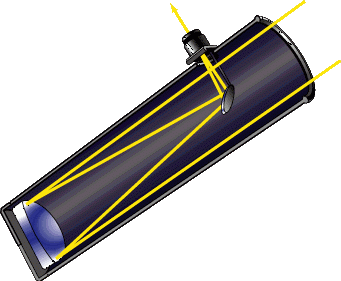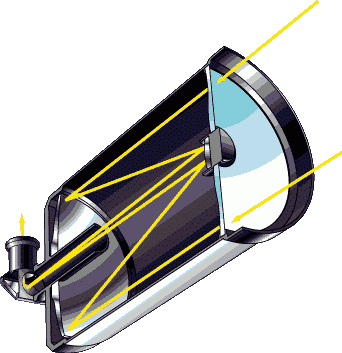When buying a telescope the first thing you need to do is to work out what type and size of telescope you’re going to buy. Always try telescopes before you buy, and don’t let sales staff push you into a poor or overly expensive sale. Check with your local astronomy club, which can give invaluable advice about what to buy according to your circumstances. You need to give them information about where you live, what you want to observe, and your budget. You should join the club, participate in stargazing sessions, and try to be actively involved in the setup of telescopes. If you can’t find a club, a local planetarium may be able to assist. A club can also advise on reputable dealers. Always buy from specialist telescope dealers, never from department stores or online. A reputable dealer will always ask questions about how much expertise you have and your astronomical interests.
Refracting Telescopes
 Refracting telescopes bend light through a curved lens to focus the light received. One advantage of refracting telescopes is that the aperture is totally clear, which means that you don’t have the problem of light scattering from brighter to dimmer areas of view. Therefore better contrast is achieved, which is especially important for the observation of planets and variable stars. Refractors also don’t need much maintenance, as recoating of the lens isn’t required. Because the lens is fixed inside the tube, misalignment doesn’t usually occur.
Refracting telescopes bend light through a curved lens to focus the light received. One advantage of refracting telescopes is that the aperture is totally clear, which means that you don’t have the problem of light scattering from brighter to dimmer areas of view. Therefore better contrast is achieved, which is especially important for the observation of planets and variable stars. Refractors also don’t need much maintenance, as recoating of the lens isn’t required. Because the lens is fixed inside the tube, misalignment doesn’t usually occur.
The size of refractors is also important. Terrestrial telescopes have the smallest refractors that may not be effective for astronomy, and its very difficult test them in a store, before buying them, but there are a few things to look for. Check for any false colors around the edges of high-contrast, such as wires against the background of a bright sky – but never look anywhere near the Sun. If you see any changes in the shape of point-like objects such as in decorative ironwork, this may mean a fault known as astigmatism. Make sure the contrast isn’t too low, and that there isn’t flaring or paling of the whole image when observing a bright object such as a light bulb. Paling may indicate poor baffling of the inside of the tube. To check for this, remove the eyepiece and look inside the tube to make sure it’s shiny to provide good reflection of light, and well-baffled to ensure that the only light you see has come through the objective lens.
Reflecting Telescopes

Reflecting telescopes use two mirrors to focus light. In the Newtonian reflecting telescope there is a large primary mirror located at the tube’s base with a small flat secondary mirror near the top of the tube. As light enters the tube, it hits the primary mirror, and is then reflected on to the secondary, and back again on to the eyepiece. The Cassegrainian reflecting telescope has a parabolic primary mirror and a hyperboloidal secondary mirror. Reflected light passed through a center hole in the primary mirror, which allows the mounting of the eyepiece on to the tube’s back end. The reflecting surface is made of aluminium.
Because there is no refraction of light there are no false colors or paling. Mirrors are much cheaper to make than lenses, which is why telescopes with apertures of 8 inches or more are reflectors. However reflectors have a few disadvantages. A “central obstr
uction” is caused by the secondary mirror, as there is light scattering and reduced contrast in the image the observer sees. The Newtonian reflectors have smaller central obstructions to address this problem. The Newtonians also produce coma, where stars at the periphery of the field of view may appear as a comet with a tail; smaller focal ratios produce larger comas. For reflectors with focal ratios of five or less a coma corrector can increase the field of view appreciably. A Ritchey-Chrétien telescope is coma-free as a result of hyperbolic primary and secondary mirrors, but the trade-off is a lower magnification, and also the Ritchey-Chrétien is more expensive than normal reflectors and the Schmidt-Cassegrain telescope (see below). As reflecting mirrors can easily be damaged they require regular maintenance and recoating.
Catadioptric Telescopes
 Catadioptric or compound telescopes incorporate the design technology of both refractors and reflectors. The basic image is produced by a steeply curved mirror, with a corrector plate located at the tube’s top to improve image quality at the field of view’s edge. Because the curvature of the mirror is only slight, false color is negligible.
Catadioptric or compound telescopes incorporate the design technology of both refractors and reflectors. The basic image is produced by a steeply curved mirror, with a corrector plate located at the tube’s top to improve image quality at the field of view’s edge. Because the curvature of the mirror is only slight, false color is negligible.
The most common catadioptric is the Schmidt-Cassegrain telescope (SCT), which uses a secondary mirror to reflect light back down the tube through a hole in the center of the primary mirror, producing a comparatively long focal ratio. One disadvantage of SCTs is that the secondary mirrors are quite large, which may result in a poorer optical performance than for a Newtonian reflector of a comparative size.
The other catadioptric is the Maksutov with its more steeply curved corrector plate. The optical performance is better than that of the SCT but over a restricted field of view. Both types of catadioptrics have viewing positions in line with the tube, as with refractor telescopes. They have much more compact tubes than for the equivalent size of refractor or reflector.


